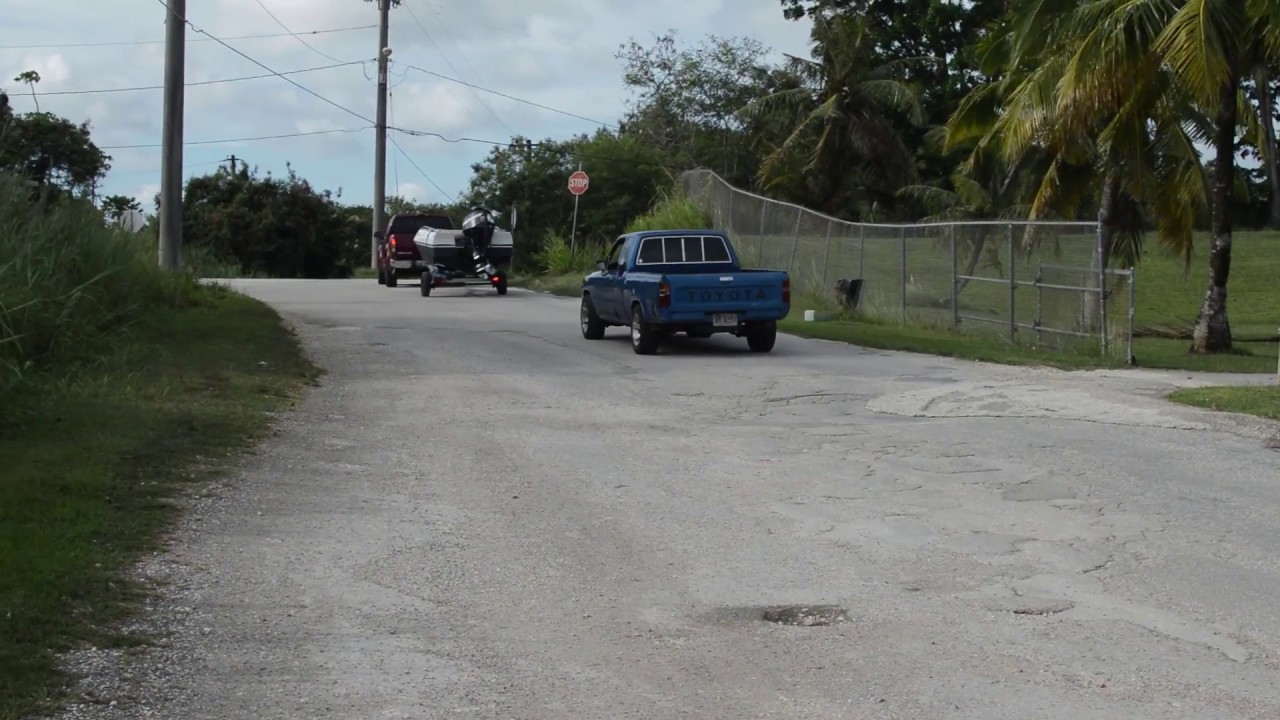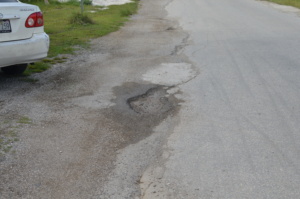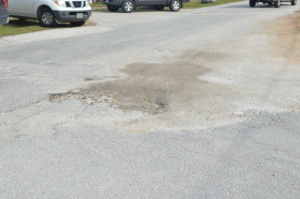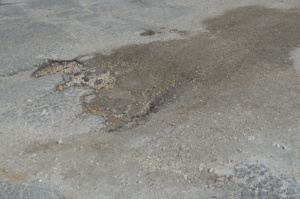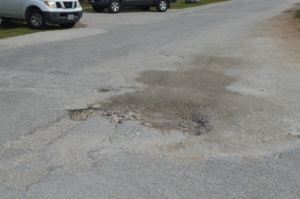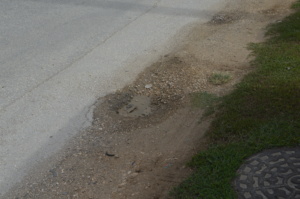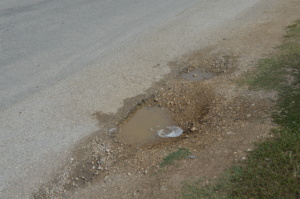By: Kreeshia Aquino
For as long as I can recall, roads on Guam have always been the target of jokes in general conversations. Even before I could drive my own car, I already held the notion that I would be swerving and plowing through potholes and cracks on almost every road on Guam.
The local news media usually bring up road repair funding and politicians promising better roads as a priority throughout the years. For example, reporter John Borja published a Pacific Daily News article on February 12, 2017. The article mentioned that government officials, village mayors, and senators have been discussing Benjamin Cruz’s Bill 36-34.
According to Bill 36-34, $50 million will be borrowed from the bond market to be used on village roads. At an annual interest rate of five percent, the money would be paid back at $3.5 million a year for the next 25 years through the Guam Highway Fund 9. In total, the Government of Guam will have paid nearly $90 million at the end of the 25-year term.
In my opinion, I think the initial $50 million is not enough to fix Guam roads. We need to calculate costs of trucking and how much does an 18 wheeler weigh in order to get an assessment properly done to help the people and the automotive industry.
There is something I needed to first clarify. According to Acting Highway Administrator Joaquin Blaz, Guam roads are divided into two main categories, routed roads and village roads. There is also a third category, which are private roads.
The federal government funds Guam’s routed roads, while the Government of Guam uses local funds to pay for the village roads. Some of the sources of the Guam Highway Fund used for routed road repair and maintenance each year come from vehicle owners paying fees for vehicle registrations, driver’s licenses, and gasoline 6.
The category I will be focusing on is the village roads. According to Public Law 33-185 or Guam’s Fiscal 2017 Budget Law 9, the Mayor’s Council of Guam received about $1,036,026.00 from the Tourist Attraction Fund for street maintenance and beautification. The Tourist Attraction Fund is one out of the four sources that help fund the need of the Mayor’s Council of Guam organization.
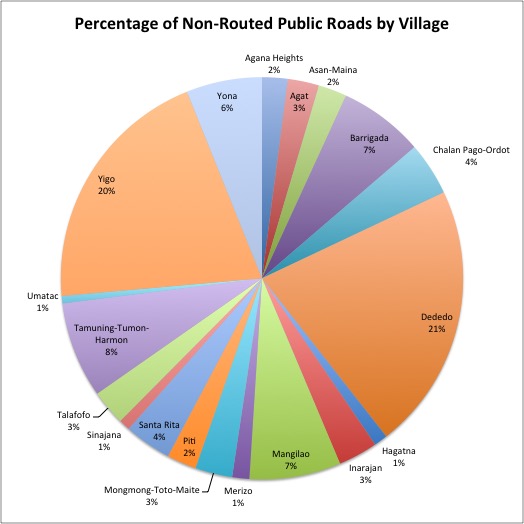
According to the pie chart, it shows how the money is distributed throughout the 19 villages on Guam based on each village’s local mileage.
According to the Guam’s Fiscal 2017 Budget Law 9, each village is given a lump sum of $20,000 plus the remaining amount from the $1,036,026.00 based on the local mileages.
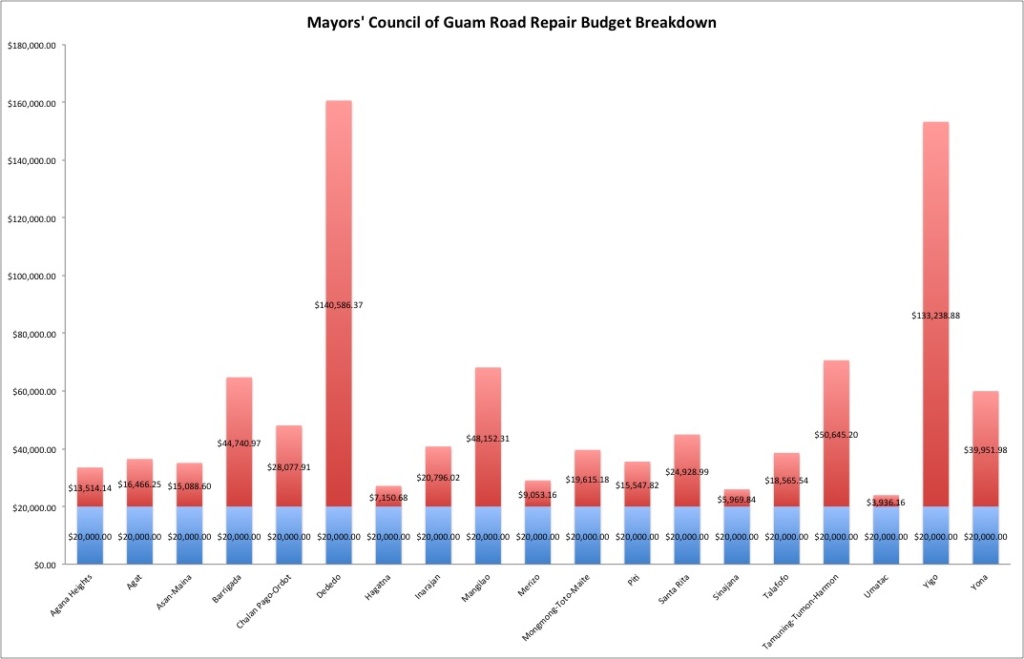
There has been recent news about several proposals to help fund village road repairs and maintenance.
First, Gov. Eddie Calvo proposed a plan that would increase the Liquid Fuel Tax by at least four cents a gallon1. This idea was mentioned in his State of the Island address on Monday, March 06, 2017.
Second, Senator Tommy Morrison proposed another plan that would appropriate about $2 million in general fund revenue to Public Works for road repairs. If this plan goes through, it would begin around the 2018 fiscal year 2.
In response to Calvo wanting to increase gas prices, Morrison explained that increasing gas prices will be a problem to the Guam community and that there are other ways to solve the road funding issue 4.
Lastly, the most costly decision is that Speaker Benjamin Cruz offered another plan. He proposed to borrow about $50 million to also help and fund village road repairs. If this proposal does goes through, it would be the single largest local investment in village road repair and construction on Guam in years 3.
Cruz supports his idea by pointing out that if Guam borrows for short-term needs then the people are in debt, but if Guam borrows for the long-term needs, like fixing roads, then it is a community investment 3. I do agree that Guam needs to borrow for long-term needs, but it still means that Guam puts itself in a position to be in even more debt.
Many of Guam’s mayors are concerned about their roads within their villages. According to the 2009 Guam Village Streets Master Plan, the mayors listed three roads that needed the most repairs in each of their village. These roads amounted to about 20 miles in total.
After calculations, the cost to fix these 20 miles amounted to about $14.5 million7.
$50 million is not enough to fix village roads because based on the numbers given, it seems that the villages need more than that. For example, the villages of Mongmong-Toto-Maite in total have 20.59 miles of non-routed public roads. The cost appropriated to the MTM mayor for street maintenance is $39, 615.18.
Knowing that about 20 miles of village roads will cost about $14.5 million, why do the villages of Mongmong-Toto-Maite are only given about $40,000 to fix their 20 miles of road. This does not make sense, and it shows that more money needs to be given to each village for road repairs.
Dededo has seven times more non-routed public roads than MTM. Would this mean that Dededo would be given seven times more the budget to fix the roads than MTM? That would mean a lot of money.
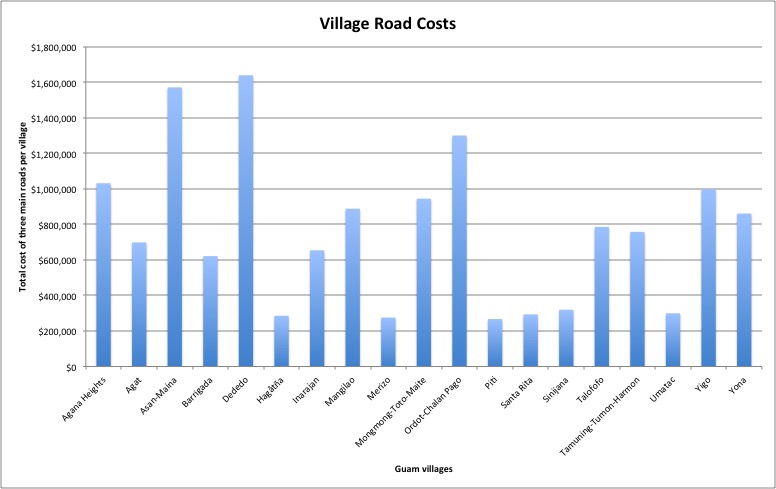
In a recent article, Public Works Director Glenn Leon Guerrero mentioned that Guam actually needs about $1 billion and that the previous records show that the amount needed increased from $746 million back in 2009 8. Road conditions have gotten worse, causing the cost to rise up over the years. This $1 billion is specifically for the village roads and not including routed roads on Guam.
Borrowing $50 million is a good start, but GovGuam will need to come up with more ways to properly fund all of Guam’s village roads. This could mean allocating money from other funds, because borrowing money means more debt. Can Guam handle more debt than it already has?
Temporary road fix with cold-mix
I have seen a lot of potholes on Guam, and I wondered if the people who are supposed to be in charge of funding, fixing, and maintaining the roads are seeing what many drivers see when they are on the road. I also wondered if there are enough people who actually complained to these politicians and public officials to fix the potholes scattered around.
Guam roads are made with asphalt—a mixture of grounded coral and oil 1.
The roads are not repaired by repaving the roads, but by covering potholes with cold-mix. This solution to the continuing problem on Guam’s roads is not efficient in the long term and costs more money in doing so.
I think that the cold-mix solution is okay for temporary fixes and considered a “band-aid” solution, but there should be more push for repaving the roads completely than just filling potholes that will eventually grow bigger and worse in a couple of months.
There is not enough funding to fix and maintain all the roads. I also learned that many of the road’s funding does not go directly to road repairs, but allocated to other maintenance.
According to Mangilao Mayor Allan G. Ungacta, each district is given a set amount of $20 million, along with the district local mileage amount. The district of Mangilao received a little over $68,000.
“With the money given, part of it goes to supplies for the daily operations of the office, labor and repair for equipment, signs for streets and off course repairs for our roads,” Ungacta said.
Mayors of each district use the funds for the local non-routed public roads. The routed roads are funded by another source. Department of Publics Works (DPW) maintains all roads on Guam.
Mayor Ungacta said the potholes are filled with cold-mix as a way to sort of fix the roads. Cold mix is asphalt material made to repair potholes in the village streets.
Ungacta said people have called or visited his office to complain about the potholes. These have included people complaining that potholes on their neighborhood streets have caused their tires to deflate.
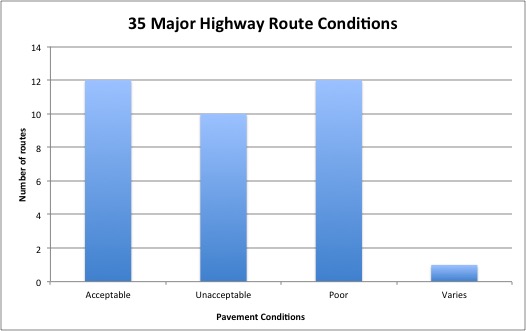
The graph, acquired from the Guam Islandwide Program Management Services, shows the road conditions of the routed roads on the island.
Many roads on Guam are poor and unacceptable, and there are very few acceptable roads 2. These do not include the local village roads. Based on the graph, the cold-mix solutions are not helping with keeping Guam’s roads acceptable to drive on well.
There are two types of mixes, one is a hot mix and the other is a cold mix. Guam uses the cold-mix version. Cold mix is also known as cold patch or cold asphalt 4.
Cold-mix is quicker to use because it does not need to be heated. It is also considered less expensive and it does not really need special expensive heavy rolling machine to apply it to the potholes 4.
When one compares the benefits of cold-mix with the more expensive and longer process of re-paving, then this temporary and easy fix sounds like a solution.
Mayor Ungacta said, “Cold-mix works temporarily. It actually does the job at filling in the potholes. But in due time, run-offs and large trucks can ruin the repairs made.”
Another mayor has also voiced out his concern about these “temporary fixes” on the roads 3. The mayor of Inarajan, Mayor Doris Lujan mentioned that the she wants a more permanent fix on these roads, and that these roads are dangerous to drivers. Mayor Lujan also mentioned that the temporary fixes create a bumpy road and that this cause wear and tear on vehicles 3.
My main concern is if many people already know that this “band-aid” solution is not really a good solution, why can’t Guam just save up all the money and eventually pay for a real repair for each road on Guam. It may cost more and take a bit longer, but the results will last longer. Guam drivers deserve smoother and safer roads.
Sources
1 http://www.pireport.org/articles/2017/03/06/guam
-governor-delivers-state-islands-address
2 http://senatormorrison.com/senator-morrison-proposes-long-term-solution-to-fund-road-repairs-2/
3 http://www.pacificislandtimes.com/single-post/2017/01/19/50M-bond-borrowing-mulled-for-road-repairs
4 http://www.guampdn.com/story/news/2017/01/18/cruz-proposes-50-million-borrowing-bill-roads/96745284/
6 http://www.guampdn.com/story/news/2015/06/26/guam-bad-roads-taxes-potholes-0627/29319573/
9 http://www.guamlegislature.com/Public_Laws_33rd/P.L.%20No.%2033-185.pdf
Acting Highway Administrator Joaquin Blaz
Division of Highways 542 N. Marine Corps Drive Tamuning, Guam 96913
Tel: (671) 649-3156
Fax: (671) 649-6178
joaquin.blaz@dpw.guam.gov
Pothole section: sources
Primary:
Contact numbers: 734-2163/5731
email:mayorallan.ungacta@yahoo.com
Secondary:
1- https://www.pinterest.com/pin/229120699767567847/
2- Guam Islandwide Program Management Services Task Order No. 1A PB DPW FHWA- GU-NH-IPMS (002) 2030 Guam Transportation Plan.
3- http://www.pacificnewscenter.com/business-pnc/utilities/12326

